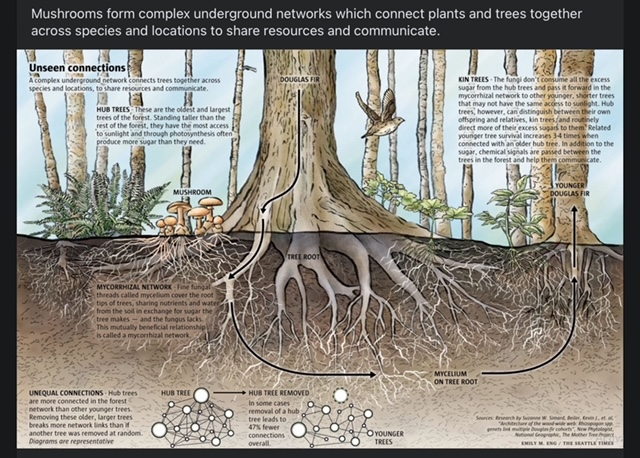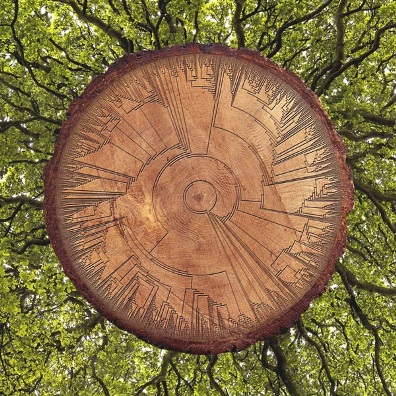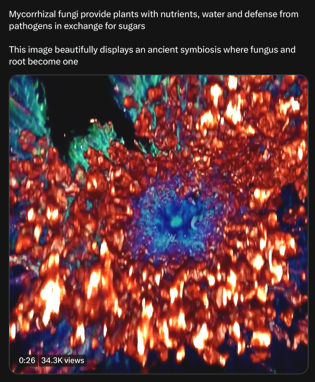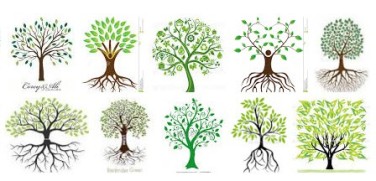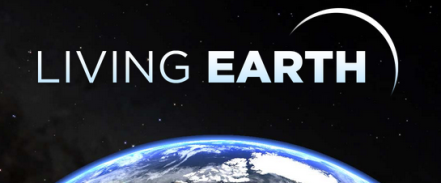Fungi: Difference between revisions
Siterunner (talk | contribs) No edit summary |
Siterunner (talk | contribs) No edit summary |
||
| (3 intermediate revisions by the same user not shown) | |||
| Line 1: | Line 1: | ||
:[https://m.youtube.com/watch?v=mh0WarijasI <font color=green> '''An Earth Day 50th Anniversary Message from Paul Stamets'''</font>] | [[File:Mushroom life in the forest.png]] | ||
* https://www.greenpolicy360.net/w/File:Mushroom_life_in_the_forest.png | |||
Take a closer look, go underground too, look microscopically ... | |||
[https://m.youtube.com/watch?v=mh0WarijasI <font color=green> '''An Earth Day 50th Anniversary Message from Paul Stamets'''</font>] | |||
:[https://www.cbc.ca/news/canada/british-columbia/paul-stamets-star-trek-mushroom-expert-mycology-1.4454204 <font color=green>'''More Mycology Starring Stamets'''</font>] | :[https://www.cbc.ca/news/canada/british-columbia/paul-stamets-star-trek-mushroom-expert-mycology-1.4454204 <font color=green>'''More Mycology Starring Stamets'''</font>] | ||
[[File:Making of Fantastic Fungi.jpg]] | |||
<big><big>The 15-Year Process Behind the Documentary ‘Fantastic Fungi’</big></big> | |||
With Filmmaker Louis Schwartzberg @ [https://movingart.com/ Moving Art] | |||
| Line 97: | Line 109: | ||
<big>The Entangled Life</big> | <big><big>The Entangled Life</big></big> | ||
| Line 145: | Line 157: | ||
[[File:A root and its mycorrhizal fungus surroundings.PNG]] | |||
<small>Image (GIF) via Merlin Sheldrake @MerlinSheldrake</small> | |||
<small>* https://twitter.com/MerlinSheldrake</small> | |||
<big>'''''A laser scan shows a plant root, in blue, enveloped by a mycorrhizal fungus, in red'''''</big> | |||
''Mycorrhizal fungi provide plants with nutrients, water and defense from pathogens in exchange for sugars'' | |||
''This image beautifully displays an ancient symbiosis where fungus and root become one'' | |||
'''Watch the animation / GIF''' | |||
* https://twitter.com/i/status/1636745438698283008 | |||
* https://twitter.com/samdknowlton/status/1636745438698283008 | |||
*https://twitter.com/i/status/1636810936483758093 | |||
<big>'''[[It's All Related]]'''</big> | |||
More | |||
'''''Entangled Life: How Fungi Make Our Worlds, Change Our Minds, & Shape Our Futures''''' | |||
by Merlin Sheldrake | |||
* https://www.amazon.com/Entangled-Life-Worlds-Change-Futures/dp/B082TS4S2L | |||
Excerpts of Reviews: | |||
''“Merlin Sheldrake’s marvelous tour of these diverse and extraordinary life forms is eye-opening on why humans should consider fungi among the greatest of earth’s marvels.... Wondrous.” (Time) | |||
''A mind-bending journey into the hidden universe of fungi, “one of those rare books that can truly change the way you see the world around you” (Helen Macdonald, author of H Is for Hawk).'' | |||
''Named One of the Best Books of the Year By '''Time; BBC; Science Focus; The Daily Mail; Geographical; The Times; The Telegraph; New Statesman; London Evening Standard Science''''' | |||
From the Publisher | |||
''When we think of fungi, we likely think of mushrooms. But mushrooms are only fruiting bodies, analogous to apples on a tree. Most fungi live out of sight, yet make up a massively diverse kingdom of organisms that supports and sustains nearly all living systems. Fungi provide a key to understanding the planet on which we live, and the ways we think, feel, and behave. | |||
In Entangled Life, the brilliant young biologist Merlin Sheldrake shows us the world from a fungal point of view, providing an exhilarating change of perspective. Sheldrake’s vivid exploration takes us from yeast to psychedelics, to the fungi that range for miles underground and are the largest organisms on the planet, to those that link plants together in complex networks known as the “Wood Wide Web”, to those that infiltrate and manipulate insect bodies with devastating precision. | |||
Fungi throw our concepts of individuality and even intelligence into question. They are metabolic masters, earth makers, and key players in most of life’s processes. They can change our minds, heal our bodies, and even help us remediate environmental disaster. By examining fungi on their own terms, Sheldrake reveals how these extraordinary organisms - and our relationships with them - are changing our understanding of how life works. | |||
🌎 | |||
[[File:Green Branching Out-2.jpg|link=https://www.greenpolicy360.net/w/GreenLinks]] | |||
'''Flora, Fauna and ... Funga | #Networks #Biodiversity ... #Microorganisms ... Living Earth''' | |||
As GreenPolicy360 has written over the decades, pay attention to the 'tiny little ones', nature, unseen and connecting life on earth... pay attention to the #Soil, it's more than dirt! e.g. mycorrhizal fungi. Pay attention to the roots, the trees, the forests ... living, interconnected webs of life on our Planet Earth. | |||
[[File:Living Earth.png]] | |||
<small>* https://www.greenpolicy360.net/w/File:Living_Earth.png</small> | |||
'''''What are mycorrhizal fungi?''''' | |||
''Mycorrhizal fungi are a group of network-forming soil fungi that form symbiotic associations with plants. Nearly all plants form symbiotic associations with mycorrhizal fungi. These associations have shaped life on earth for more than 475 million years.'' | |||
''Nearly all plants of Earth form a symbiosis with mycorrhizal fungi. These fungi have altered the evolutionary history of the planet.'' | |||
See more at -- https://www.spun.earth/networks/mycorrhizal-fungi | |||
🌎 | |||
[[Category:Alternative Agriculture]] | [[Category:Alternative Agriculture]] | ||
[[Category:Anthropocene]] | |||
[[Category:Biodiversity]] | [[Category:Biodiversity]] | ||
[[Category:Bioneers]] | |||
[[Category:Biosphere]] | |||
[[Category:Climate Change]] | |||
[[Category:Climate Policy]] | |||
[[Category:Earth]] | |||
[[Category:Earth360]] | |||
[[Category:Earth Law]] | |||
[[Category:Earth Observations]] | |||
[[Category:Earth Science]] | |||
[[Category:Eco-ethics]] | |||
[[Category:Ecological Economics]] | |||
[[Category:Ecology Studies]] | |||
[[Category:EOS eco Operating System]] | |||
[[Category:Forest]] | |||
[[Category:Forests]] | |||
[[Category:GreenPolicy360]] | |||
[[Category:Green Politics]] | |||
[[Category:Health]] | |||
[[Category:Land Ethic]] | |||
[[Category:Microbiology]] | [[Category:Microbiology]] | ||
[[Category:Microorganism]] | [[Category:Microorganism]] | ||
[[Category:Natural Capital]] | |||
[[Category:Natural Resources]] | |||
[[Category:Planet Citizen]] | |||
[[Category:Planet Citizens]] | |||
[[Category:Planet Citizens, Planet Scientists]] | |||
[[Category:Resilience]] | |||
[[Category:Seventh Generation Sustainability]] | |||
[[Category:Soil]] | |||
[[Category:Strategic Demands]] | |||
[[Category:Sustainability]] | |||
[[Category:Sustainability Policies]] | |||
[[Category:ThinBlueLayer]] | |||
[[Category:Wetlands]] | |||
[[Category:Whole Earth]] | |||
[[Category:Wildlife]] | |||
[[Category:Zoology]] | |||
Latest revision as of 02:35, 25 March 2023
Take a closer look, go underground too, look microscopically ...
An Earth Day 50th Anniversary Message from Paul Stamets
The 15-Year Process Behind the Documentary ‘Fantastic Fungi’
With Filmmaker Louis Schwartzberg @ Moving Art
Millions of Fungi
Every living thing is crawling with microorganisms — and you need them to survive.
Mycologist tales ...
Throughout Tibet, Micronesia, on Borneo, and on São Tomé and Príncipe (tiny islands off the coast of West Africa), Perry has surveyed “hotspots,” or regions with high levels of endemic, endangered plants and wildlife.
According to Conservation International, there are 35 total hotspots in the world that comprise just 2.3 percent of Earth’s landmass, yet these regions hold more than half of species that can’t be found anywhere else.
The annual http://www.esf.edu/species/mission.htm Most Exciting New Discoveries list by the International Institute for Species Exploration...
The International Institute for Species Exploration seeks to increase awareness of the biodiversity crisis and an appreciation for the importance of taxonomy, natural history, and collections in the exploration and conservation of animals, plants, and microbes.
Although about 18,000 species are discovered and named each year, we are losing ground. Species are disappearing at least as rapidly and unless we collect and describe them, evidence that they ever existed and all that we might have learned from them will be gone.
In the Hawaiian archipelago — the most isolated island chain in the world — more than 90 percent of plants are unique to their environment, and nearly 30 percent are threatened and/or endangered according to the state’s Division of Forestry and Wildlife.
“We’re collecting the baseline data,” Professor Perry says. “We’re surveying the diversity of organisms and determining what’s there. In all these places, we’re saying, ‘No one’s ever been to this place and done a full documentation of the fungal biodiversity that’s here.’ That’s the starting point.”
“With the endophyte project, we’re talking about big evolutionary questions,” Perry explains. “When we look at endophytes that are living in native plants, we want to know: Did they co-evolve with their host plants? Did they go through adaptive radiation (rapid evolutionary diversification of an organism)? Where did they come from?”
Mushrooms today, Mushrooms tomorrow
Microbial Boom
The Unseen and the Seen
“It’s necessary to do this because no one else has,” Bacon says. “We’re now aware that there’s no such thing as a single entity on this planet. Every living thing is made up of a conglomerate of organisms that is contributing to its success.”
“We’re creating a living library of all these fungi,” Perry explains. “We’ll identify them, then we’ll send them off to the USDA, about 1,000 species. They’ll grow them and then cryopreserve them. Essentially, once you freeze-dry these things, they’ll last forever, as far as we know.”
Ready and waiting for some scientist of the future — perhaps Perry down the road or one of his students — to extract the compounds and solve another scientific mystery in the evolutionary tale of life on earth. “Our estimate is that global fungal diversity ranges from 3.5 to 5 million species,” he says. “So far we’ve only documented about 100,000 of those. That tells you how much there is out there to be done. To me, that’s incredibly exciting.”
8 Million (and Counting) Species We Don’t Know
By Edward O. Wilson
March 3, 2018 / New York Times
https://www.nytimes.com/2018/03/03/opinion/sunday/species-conservation-extinction.html
The most striking fact about the living environment may be how little we know about it. Even the number of living species can be only roughly calculated. A widely accepted estimate by scientists puts the number at about 10 million. In contrast, those formally described, classified and given two-part Latinized names (Homo sapiens for humans, for example) number slightly more than two million. With only about 20 percent of its species known and 80 percent undiscovered, it is fair to call Earth a little-known planet.
- To effectively manage protected habitats, we must also learn more about all the species of our planet and their interactions within ecosystems.
The best-explored groups of organisms are the vertebrates (mammals, birds, reptiles, amphibians, fishes), along with plants, especially trees and shrubs. Being conspicuous, they are what we familiarly call “wildlife.” A great majority of other species, however, are by far also the most abundant. I like to call them “the little things that run the world.” They teem everywhere, in great number and variety in and on all plants, throughout the soil at our feet and in the air around us. They are the protists, fungi, insects, crustaceans, spiders, pauropods, centipedes, mites, nematodes and legions of others whose scientific names are seldom heard by the bulk of humanity. In the sea and along its shores swarm organisms of the other living world — marine diatoms, crustaceans, ascidians, sea hares, priapulids, coral, loriciferans and on through the still mostly unfilled encyclopedia of life.
Do not call these organisms “bugs” or “critters.” They too are wildlife. Let us learn their correct names and care about their safety. Their existence makes possible our own. We are wholly dependent on them.
·······················································
································
The Entangled Life
GreenPolicy360: We often speak of green eco-politics with an eye on how life on earth is interrelated -- here, Marlin Sheldrake looks closely at the mysteries and marvels of fungi as a web of life... a web that is supporting and revealing how connections go deeper, much deeper, than we almost always tend to see. Here, linear distinctions, class distinctions, individual boundaries merge with systems of life that overlap, systems that mutually support larger systems. Well, let Merlin Sheldrake explain...
From the Publisher: When we think of fungi, we probably think of mushrooms. But mushrooms are only fruiting bodies, analogous to apples on a tree. Most fungi live out of sight, yet make up a massively diverse kingdom of organisms that support and sustain nearly all living systems. The more we learn about fungi, the less makes sense without them.
Sheldrake’s mind-bending journey into this hidden world ranges from yeast to psychedelics, to the fungi that sprawl for miles underground and are the largest organisms on the planet, to those that link plants together in complex networks known as the ‘Wood Wide Web’, to those that infiltrate and manipulate insect bodies with devastating precision.
Fungi throw our concepts of individuality and even intelligence into question. They can change our minds, heal our bodies, and even help us remediate environmental disaster. By examining fungi on their own terms, Sheldrake reveals how these extraordinary organisms – and our relationships with them – are changing our understanding of how life works.
The Bioneers talks with Merlin Sheldrake about the Entangled Life
- https://bioneers.org/entangled-life-ze0z2007/ - Excerpt from the Book
Buy the Book - Entangled Life
How Fungi Make Our Worlds, Change Our Minds, & Shape Our Futures
Symbiotic Rootscapes
In this photoessay, Merlin uses laser scans of roots to explore the astonishing intercourse between plants and their fungal partners, subterranean worlds of intimacies within intimacies.
Granta 153: Second Nature, 19 November 2020
Why the hidden world of fungi is essential to life on Earth
Fungi have long supported and enriched life on our planet. They must be protected as fiercely as animals and plants.
Image (GIF) via Merlin Sheldrake @MerlinSheldrake
* https://twitter.com/MerlinSheldrake
A laser scan shows a plant root, in blue, enveloped by a mycorrhizal fungus, in red
Mycorrhizal fungi provide plants with nutrients, water and defense from pathogens in exchange for sugars
This image beautifully displays an ancient symbiosis where fungus and root become one
Watch the animation / GIF
More
Entangled Life: How Fungi Make Our Worlds, Change Our Minds, & Shape Our Futures
by Merlin Sheldrake
Excerpts of Reviews:
“Merlin Sheldrake’s marvelous tour of these diverse and extraordinary life forms is eye-opening on why humans should consider fungi among the greatest of earth’s marvels.... Wondrous.” (Time)
A mind-bending journey into the hidden universe of fungi, “one of those rare books that can truly change the way you see the world around you” (Helen Macdonald, author of H Is for Hawk).
Named One of the Best Books of the Year By Time; BBC; Science Focus; The Daily Mail; Geographical; The Times; The Telegraph; New Statesman; London Evening Standard Science
From the Publisher
When we think of fungi, we likely think of mushrooms. But mushrooms are only fruiting bodies, analogous to apples on a tree. Most fungi live out of sight, yet make up a massively diverse kingdom of organisms that supports and sustains nearly all living systems. Fungi provide a key to understanding the planet on which we live, and the ways we think, feel, and behave.
In Entangled Life, the brilliant young biologist Merlin Sheldrake shows us the world from a fungal point of view, providing an exhilarating change of perspective. Sheldrake’s vivid exploration takes us from yeast to psychedelics, to the fungi that range for miles underground and are the largest organisms on the planet, to those that link plants together in complex networks known as the “Wood Wide Web”, to those that infiltrate and manipulate insect bodies with devastating precision.
Fungi throw our concepts of individuality and even intelligence into question. They are metabolic masters, earth makers, and key players in most of life’s processes. They can change our minds, heal our bodies, and even help us remediate environmental disaster. By examining fungi on their own terms, Sheldrake reveals how these extraordinary organisms - and our relationships with them - are changing our understanding of how life works.
🌎
Flora, Fauna and ... Funga | #Networks #Biodiversity ... #Microorganisms ... Living Earth
As GreenPolicy360 has written over the decades, pay attention to the 'tiny little ones', nature, unseen and connecting life on earth... pay attention to the #Soil, it's more than dirt! e.g. mycorrhizal fungi. Pay attention to the roots, the trees, the forests ... living, interconnected webs of life on our Planet Earth.
* https://www.greenpolicy360.net/w/File:Living_Earth.png
What are mycorrhizal fungi?
Mycorrhizal fungi are a group of network-forming soil fungi that form symbiotic associations with plants. Nearly all plants form symbiotic associations with mycorrhizal fungi. These associations have shaped life on earth for more than 475 million years.
Nearly all plants of Earth form a symbiosis with mycorrhizal fungi. These fungi have altered the evolutionary history of the planet.
See more at -- https://www.spun.earth/networks/mycorrhizal-fungi
🌎
- Alternative Agriculture
- Anthropocene
- Biodiversity
- Bioneers
- Biosphere
- Climate Change
- Climate Policy
- Earth
- Earth360
- Earth Law
- Earth Observations
- Earth Science
- Eco-ethics
- Ecological Economics
- Ecology Studies
- EOS eco Operating System
- Forest
- Forests
- GreenPolicy360
- Green Politics
- Health
- Land Ethic
- Microbiology
- Microorganism
- Natural Capital
- Natural Resources
- Planet Citizen
- Planet Citizens
- Planet Citizens, Planet Scientists
- Resilience
- Seventh Generation Sustainability
- Soil
- Strategic Demands
- Sustainability
- Sustainability Policies
- ThinBlueLayer
- Wetlands
- Whole Earth
- Wildlife
- Zoology
